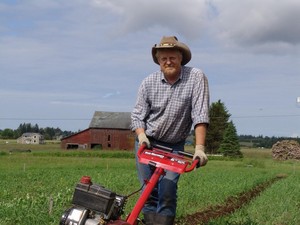19 Sep Sat 2009
Busy September
Back when I was a fruit tramp (i.e. migrant worker), September and October were busy months. The Golden Delicious apples started around September 10th and then we moved right into the Red Delicious after the Goldens. After the Reds were done, there were Romes and Winesaps, as well as pickup work at orchards that had juicer apples. It was the dessert at the end of a long season and all of us had money in our pockets. I usually took a week hike up in the Pasayten Wilderness after apple harvest, but there was also a Barter Faire somewhere in Okanagan County (north central Washington). When I did my hike each year, I always took all my winter gear. Sometimes I used it; sometimes I hiked in shorts and runners and carried all my gear. It was quite a nice time up in the high country. I kind of miss those carefree days of youth.
Now, I have all my prunes in and some of my apples. The Asian pears are still on the trees, but the European pears are picked. I have been canning tomatoes and dill pickles. I have two batches of sauerkraut in jars and there are enough onions and potatoes for winter in the canning room. The wheat and spelt is harvested, but I haven't finished threshing the spelt yet. Some barley is cut and threshed, but most of it will just sit in the field as winter cover. Some cover crops are up and my fall carrots, rutabagas and parsnips look great. However, I am still swamped. I need to get my favas done, but if I don't, I already have enough for seed and the rest can just sit and be tilled under next year. I am publicizing my "halfsies" program locally, but no takers so far. This program consists of people coming out to the farm and picking favas or dried beans and keeping half of what they picked. That way, I get my crop picked and they get food for their labor. The educational value of this program is that they realize they cannot make even minimum wage picking these items, so they have to think outside the money economy box, as well as appreciate what the sustainable farmer is doing for them. I have potatoes in the ground that need to come out and I am trying to do the same with the potatoes. Most of the potatoes will likely just stay in the ground and recycle the nutrients. Since I rotate my crops every year, this is not a problem and I will likely have squash or corn next year where the potatoes are now.
The winter rains have already started, on a sporadic basis, and there is plenty of soil moisture. I have already coiled up most of my irrigation hose. A word about my irrigation. I use regular 5/8" garden hose and I drag the hose up and down the north south paths, then connect to a hose that runs east and west in whatever bloc I am watering. I use an impact sprinkler on a tripod and a 10-day cycle. This works well and does not stress our well. For my tomatoes, I put down some soaker hoses and watered as needed. This worked well in preventing late blight and did not incur the cost of a drip irrigation system. I think I will buy a few more soaker hoses next year and increase their use. The advantage to using a mobile hose system is that you can start with a few hoses and bypass the upfront capital costs of laying down PVC pipe. I suppose the environmental impacts and embedded calories of garden hose and PVC pipe are comparable per foot, but an irrigation system that is mobile uses less materials. Another advantage is that it can be changed at will. There is some time involved in changing water, but this takes only 5-15 minutes per set. All in all, my mobile hose system works quite well for my scale.
Well, I guess I should do some work.

